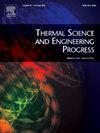Integrated life cycle assessment and economic analysis of a novel hybrid cooling-power system for industrial waste heat recovery
IF 5.4
3区 工程技术
Q2 ENERGY & FUELS
引用次数: 0
Abstract
To address the technical challenges of large-scale low-temperature waste heat recovery in industrial processes, a novel heat-integrated combined cooling and power generation system (HIOAS) and a non-heat-integrated combined cooling and power generation system (OAS) model were established. The OAS and HIOAS systems achieve hierarchical energy utilization by integrating the refrigeration cycle with the power generation cycle. The economic analysis and environmental impacts of both systems were evaluated. The Robin Smith analysis model was employed to conduct an economic analysis, which showed that HIOAS reduces the payback period from 3.81 years to 3.66 years and increases annual economic benefits by $6,532.90 y−1 in comparison to OAS. The ReCiPe 2016 Midpoint (H) method was employed combined with SimaPro 9.0.0.48 software to conduct a life cycle assessment (LCA) for the environmental analysis. The results indicate that thermal integration technology effectively accomplishes energy conservation and emission reduction, as HIOAS betters OAS in 18 normalization analysis environmental impact indicators. Furthermore, the system construction phase was the most significant contributor to environmental impacts, with human carcinogenic toxicity potential (HCTP), marine ecotoxicity potential (METP), and human non-carcinogenic toxicity potential (HnCTP) being the most significant environmental impacts. These three environmental impacts were predominantly derived from sulfur-containing tailings, as indicated by the LCA contribution analysis. In conclusion, this investigation offers a novel approach to industrial waste heat recovery that effectively balances environmental sustainability and economic feasibility, as well as valuable insights for energy system optimization.

一种新型工业余热回收冷-电混合系统的综合生命周期评价与经济分析
为了解决工业过程中大规模低温余热回收的技术难题,建立了一种新型热集成联合制冷与发电系统(HIOAS)和非热集成联合制冷与发电系统(OAS)模型。OAS和HIOAS系统通过将制冷循环与发电循环结合起来实现分层能源利用。对两个系统的经济分析和环境影响进行了评价。采用Robin Smith分析模型进行经济分析,结果表明,HIOAS将投资回收期从3.81年缩短至3.66年,与OAS相比,年经济效益增加了6532.90美元y−1。采用ReCiPe 2016 Midpoint (H)法结合SimaPro 9.0.0.48软件进行生命周期评价(LCA)进行环境分析。结果表明,热集成技术有效地实现了节能减排,HIOAS在18项归一化分析环境影响指标上优于OAS。系统建设阶段对环境的影响最大,其中人类致癌毒性潜力(HCTP)、海洋生态毒性潜力(METP)和人类非致癌毒性潜力(HnCTP)是最显著的环境影响。LCA贡献分析表明,这三种环境影响主要来自含硫尾矿。总之,本研究为工业废热回收提供了一种新的方法,有效地平衡了环境可持续性和经济可行性,并为能源系统优化提供了有价值的见解。
本文章由计算机程序翻译,如有差异,请以英文原文为准。
求助全文
约1分钟内获得全文
求助全文
来源期刊

Thermal Science and Engineering Progress
Chemical Engineering-Fluid Flow and Transfer Processes
CiteScore
7.20
自引率
10.40%
发文量
327
审稿时长
41 days
期刊介绍:
Thermal Science and Engineering Progress (TSEP) publishes original, high-quality research articles that span activities ranging from fundamental scientific research and discussion of the more controversial thermodynamic theories, to developments in thermal engineering that are in many instances examples of the way scientists and engineers are addressing the challenges facing a growing population – smart cities and global warming – maximising thermodynamic efficiencies and minimising all heat losses. It is intended that these will be of current relevance and interest to industry, academia and other practitioners. It is evident that many specialised journals in thermal and, to some extent, in fluid disciplines tend to focus on topics that can be classified as fundamental in nature, or are ‘applied’ and near-market. Thermal Science and Engineering Progress will bridge the gap between these two areas, allowing authors to make an easy choice, should they or a journal editor feel that their papers are ‘out of scope’ when considering other journals. The range of topics covered by Thermal Science and Engineering Progress addresses the rapid rate of development being made in thermal transfer processes as they affect traditional fields, and important growth in the topical research areas of aerospace, thermal biological and medical systems, electronics and nano-technologies, renewable energy systems, food production (including agriculture), and the need to minimise man-made thermal impacts on climate change. Review articles on appropriate topics for TSEP are encouraged, although until TSEP is fully established, these will be limited in number. Before submitting such articles, please contact one of the Editors, or a member of the Editorial Advisory Board with an outline of your proposal and your expertise in the area of your review.
 求助内容:
求助内容: 应助结果提醒方式:
应助结果提醒方式:


